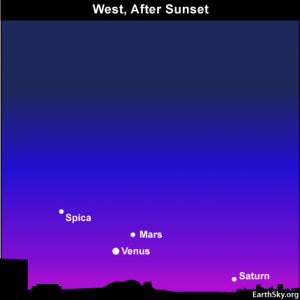Courtesy of EarthSky
A Clear Voice for Science
www.EarthSky.org

 How soon can you spot Venus above the western horizon as the sun sets? From the northern hemisphere, the ecliptic – the line in the sky that marks the path of the sun, as well as its attendant planets – makes a shallow angle with the horizon. The slant of the ecliptic is more perpendicular to the horizon in the southern hemisphere, making Venus stand tall during twilight.
How soon can you spot Venus above the western horizon as the sun sets? From the northern hemisphere, the ecliptic – the line in the sky that marks the path of the sun, as well as its attendant planets – makes a shallow angle with the horizon. The slant of the ecliptic is more perpendicular to the horizon in the southern hemisphere, making Venus stand tall during twilight.
Shining at magnitude -4.4, Venus easily pierces the northern hemisphere’s thick summer air. You’ll likely have to wait a bit longer for the sky to darken to see Mars just 2.5 degrees from Venus – at least with an unaided eye. The Red Planet is magnitude 1.5, making Venus 200 times as bright. A modest pair of binoculars will show our neighboring worlds in the same field of view.
The pairing of Venus and Mars is flanked by two first-magnitude objects. About 7 degrees in the direction away from the sun is Spica, the brightest star of the constellation Virgo. Look twice Spica’s distance toward the sun and you may find Saturn, though it will be obscured in the twilight glare. Watch how the gap between Spica and Venus shrink throughout the upcoming week. They will be closest on August 31.
After Venus, the brightest of all planets, sets in the west tonight, watch for Jupiter, the second brightest planet, to rise in the east.
Related:
Looking for a sky almanac? EarthSky recommends . . .
Written by Stuart Goldman
Astronomy Picture of the Day from NASA/JPL
U.S. Naval Observator Astronomical Information center
The York County Astronomical Society
 Print This Post
Print This Post








